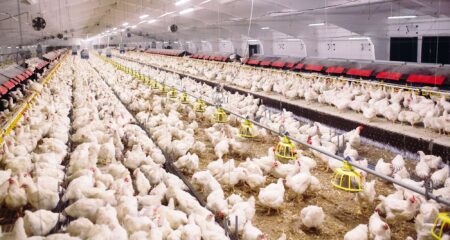Key Takeaways
- Weather split the state — Northern Illinois had late-August rains supporting crop fill, while the southern two-thirds had one of the driest Augusts on record.
- Corn is ahead of average growth stages — More Illinois corn has reached dough, dent, and mature growth stages compared to respective five-year averages, though disease pressure like southern rust and tar spot may slightly impact yields.
- Soybean conditions lag behind the national average — Most fields are setting pods and dropping leaves earlier than average, but overall crop ratings show more stress in Illinois compared to the national average.
USDA published the latest Crop Progress report on Tuesday, Sept. 2. Here’s a closer look at recent weather and the status of Illinois’ most important crops in late-August.
Weather
Steve Brand, commercial agriculture specialist in Dekalb County for Illinois Extension, said in an Illinois Crop Update article, “After a wet couple of weeks up north we are all but back to normal precipitation levels for the season.”
He noted that northern Illinois saw between 1–4 inches in storms in late August and have primed plants for a strong finish through ear and pod fill. Disease has been more prevalent due to the moisture and dropping temperatures below 90 degrees.
However, Ryan Gentle, agronomist for Wyffels Hybrids, said, “Most of the southern two-thirds of Illinois had one of the top five driest Augusts on record.”
In Tuesday’s Crop Progress report, USDA said farmers had 6.9. days suitable for fieldwork the week that ended Aug. 31, compared to 5.5 days this time last year.
USDA rated Indiana topsoil moisture 21% very short, 33% short, 45% adequate, and 1% surplus. Subsoil moisture conditions in the state were rated 19% very short, 29% short, 51% adequate, and 1% surplus.
Corn
Acreage Estimates
According to the June 30 Acreage report, Illinois farmers planted 11 million acres of corn in 2025. This is up from 10.8 million acres from the previous year.
Pest and Disease Pressure
Brand said, “Tar spot is usually the big fear, disease-wise, but this season early winds from the south brought up southern rust. Generally not a concern for robbing yields, this disease does look like it may lower yields slightly on fields that were not sprayed with fungicides this season. Since [southern rust] does not overwinter in the north, inoculum is not an issue for next season.”
He said tar spot is beginning to move into the upper canopies, but it is not recommended to spray this late in the season due to lack of return on investment from the sprays.
Brand said he’s seen multiple fields with some tip back on corn ears.
“Generally, environmental conditions can cause poor pollination. The extreme heat waves and droughts in different regions across northern Illinois would be my guess to why we are seeing this across the region,” he explained.
A map published by the Crop Protection Network shows there are 22 positive tar spot cases.
Crop Protection Network
Corn Dough
The latest Crop Progress report said 96% of Illinois’ corn crop has reached the dough stage. The five-year average is 91%. Last year at this time 95% of the state’s corn had reached the dough stage.
Corn Dented
USDA said 72% of Illinois’ corn crop has reached the dent stage, ahead of the five-year average of 65%. Last year at this time 69% of the state’s corn had reached the dent stage.
Corn Mature
The latest Crop Progress report said 15% of the Illinois corn crop has reached maturity. The five-year average is 13%. Last year at this time 22% of the state’s corn had reached maturity.
Corn Condition
USDA rated Illinois corn 8% very poor, 9% poor, 28% fair, 43% good, and 12% excellent for the week that ended Aug. 31.
The 18-state average rating is 3% very poor, 6% poor, 22% fair, 50% good, and 19% excellent.
Soybeans
Acreage Estimates
The Acreage report published June 30 said Illinois planted 10.5 million acres of soybeans this year. That is down from 10.8 million acres in 2024.
Pest and Disease Pressure
Brand reported, “ I found white mold for the first time this season in some lodged beans, but I again expect the disease to be low based on the drought and high temperatures we had at soybean flowering.”
Doug Gucker, local food systems and small farms educator in Dewitt, Macon, and Platt Counties with Illinois Extension, reported late-season insect and disease pests are beginning to show in some soybean fields.
Soybeans Setting Pods
The latest Crop Progress report said 95% of Illinois soybeans are setting pods. The five-year average is 93%, and progress was at 96% this time last year.
Soybeans Dropping Leaves
USDA reported 16% of Illinois soybeans are dropping leaves. The five-year average is 5%, and progress was at 13% this time last year.
Soybean Condition
USDA rated Illinois soybeans 9% very poor, 13% poor, 25% fair, 41% good, and 12% excellent for the week that ended Aug. 31.
The 18-state average ratings are 3% very poor, 7% poor, 25% fair, 51% good, and 14% excellent over the same time period.
Pasture and Range
USDA rated pasture and range conditions in the state 12% very poor, 12% poor, 36% fair, 35% good, and 5% excellent.
The 48-state average is 11% very poor, 20% poor, 31% fair, 29% good, and 9% excellent.


:max_bytes(150000):strip_icc()/IMG_1591-2048x1365-362687ca596f4814967abffff2b4be2c.jpg)
:max_bytes(150000):strip_icc()/SuccessfulFarmingShareImage-8fed6410b43147a19ed5ea1e3243227f.png)



:max_bytes(150000):strip_icc()/IMG_5402-2000-b4d3b346719e43ba9762f243e32696a4.jpg)

:max_bytes(150000):strip_icc()/IMG_7575-ac6db3006a2145109bcc2df421c7a962.jpeg)

:max_bytes(150000):strip_icc()/Markets-3-Corn-up-3-19bdbeee0041452db8bce0a0f1c8b883.jpeg)